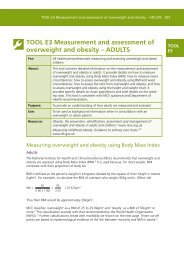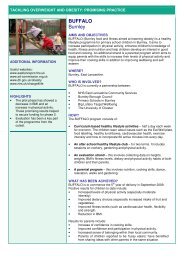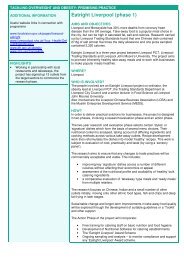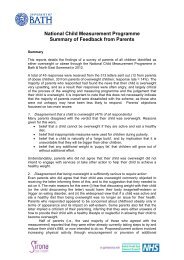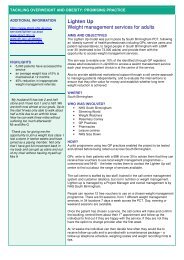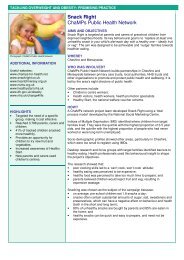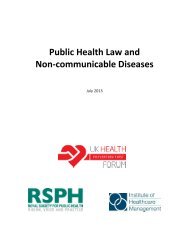The Challenge of Non-Communicable Diseases and Road Traffic ...
The Challenge of Non-Communicable Diseases and Road Traffic ...
The Challenge of Non-Communicable Diseases and Road Traffic ...
Create successful ePaper yourself
Turn your PDF publications into a flip-book with our unique Google optimized e-Paper software.
An Overview 27<br />
Life expectancy has stagnated or gone down in<br />
many African countries, reflecting worsening social<br />
<strong>and</strong> economic conditions, <strong>and</strong> the impacts <strong>of</strong><br />
AIDS <strong>and</strong> related diseases especially in Southern<br />
Africa [109]. Nevertheless, large gains in life expectancy<br />
have occurred since 1990 in some SSA countries;<br />
most notably, increases <strong>of</strong> 12-15 years for<br />
men <strong>and</strong> women in Angola, Ethiopia, Niger, <strong>and</strong><br />
Rw<strong>and</strong>a are due to HIV-control strategies <strong>and</strong> a reduction<br />
<strong>of</strong> childhood diseases [122]. All four SSA<br />
regions had at least a 10 percent decline in adult<br />
mortality from 2004 to 2010, particularly in Eastern<br />
<strong>and</strong> Southern SSA.<br />
Global healthy life expectancy (HALE) increased<br />
over the period 1990-2010, mainly<br />
through reductions <strong>of</strong> child <strong>and</strong> adult mortality<br />
rather than through reductions in disability [123].<br />
For similar reasons, overall HALE also rose in the<br />
SSA regions (East, West, <strong>and</strong> Central), with the<br />
FIGURE 13: Projected Age-Specific Increase in Male<br />
<strong>and</strong> Female Populations in SSA, 2010 to 2030<br />
85+<br />
80-84<br />
75-79<br />
65-69<br />
60-64<br />
55-59<br />
50-54<br />
45-49<br />
40-44<br />
35-39<br />
30-34<br />
25-29<br />
20-24<br />
15-19<br />
10-14<br />
5-9<br />
female<br />
0-4<br />
male<br />
0.0 0.5 1.0 1.5 2.0 2.5 3.0<br />
Source: Authors from [119] (medium variant)<br />
Factor increase in population size 2010 to 2030<br />
exception <strong>of</strong> Southern SSA due to adult mortality<br />
from HIV/AIDS.<br />
Chronic conditions occur in younger age groups<br />
more commonly in SSA than in developed countries<br />
[83]. High burdens <strong>of</strong> CVD are attributable not just<br />
to the epidemiological transition, but also to the relatively<br />
early age at which CVD manifests in combination<br />
with the large population <strong>of</strong> individuals who<br />
are young or middle aged [34].<br />
<strong>The</strong> number <strong>of</strong> elderly persons in SSA is projected<br />
to double between 2000 <strong>and</strong> 2030 (Figure<br />
13). Advancing age is associated with increased risk<br />
<strong>of</strong> a number <strong>of</strong> chronic diseases [124], more so for<br />
people living with HIV <strong>and</strong> AIDS (PLWH) [125].<br />
Population growth <strong>and</strong> ageing alone are driving a<br />
substantial part <strong>of</strong> the projected increases in cancer<br />
by 2030. Nevertheless, health <strong>and</strong> wellbeing in older<br />
age is determined more by chronic disease status<br />
<strong>and</strong> co-morbidity than by age [126].<br />
3.3. Socio-Economic Determinants<br />
<strong>and</strong> Distributions<br />
Increased prevalence <strong>of</strong> both communicable <strong>and</strong><br />
NCDs in disadvantaged populations is caused by<br />
the same social conditions [127-128]. Poverty <strong>and</strong><br />
the challenges <strong>of</strong> poverty, such as overcrowding,<br />
insanitary environments, malnutrition, infections,<br />
<strong>and</strong> psychosocial stress, play a critical role in the rise<br />
<strong>of</strong> NCDs in poor <strong>and</strong> rural communities [114, 129].<br />
Differential exposures throughout a person’s lifetime<br />
result in a range <strong>of</strong> consequences <strong>and</strong> outcomes<br />
(Figure 14) – Africa may have some specific insights<br />
to contribute on these linkages.<br />
As noted before, Africa’s growth has been robust<br />
(averaging 5-6 percent GDP growth a year) since<br />
the turn <strong>of</strong> the new century, making important contributions<br />
to poverty reduction. Income inequality,<br />
however, remains high <strong>and</strong> SSA has some <strong>of</strong> the<br />
highest income inequalities in the world. Nevertheless,<br />
there has been a trend toward improvement in<br />
several countries [82, 131]<br />
Wealthy communities experience a higher risk <strong>of</strong><br />
chronic diseases, while poor communities experience<br />
a higher risk <strong>of</strong> communicable diseases <strong>and</strong> a<br />
double burden <strong>of</strong> communicable diseases <strong>and</strong> NCDs




